WASHINGTON — On Friday night in Woodbridge, Virginia, the Potomac Nationals gave away Steven Souza, Jr. bobbleheads, commemorating the catch the outfielder made that saved Jordan Zimmermann’s no-hitter on the final day of the 2014 regular season.
The timing may have felt odd, as Souza has been a member of the Tampa Bay Rays for nearly six months, after being traded this offseason. But the final piece of that trade didn’t even join the Nationals’ organization until later in the weekend, thanks to a bizarre quirk in baseball’s extensive rule book.
The three-team deal saw Souza and minor leaguer Travis Ott go to Tampa Bay, with Joe Ross (who made his second Major League start Saturday) and a player to be named later returned from the San Diego Padres. Everyone knew at the time that player was going to be shortstop Trea Turner, but neither team could announce that fact at the time, leading to a six-month charade of tiptoeing around the rules.
The player to be named later (PTBNL) is simultaneously one of baseball’s most oft-joked about and most misunderstood anomalies. It is used for a couple different reasons, the most common of which is when a player with questionable value is traded. Depending on a number of factors including waiver claims, injuries, and positional need, the other team is allowed to pick between a list of pre-agreed upon options.
But after the Incaviglia Rule went into place in the ’80s, forcing teams to wait a full calendar year to trade a player after he is drafted, a loophole opened to use the PTBNL for recent draftees to circumvent the process. That’s how Turner was stuck in the Padres’ system all the way until last weekend, once a year had passed since his initial signing.
Thankfully, Turner’s bizarre predicament has prompted MLB to amend the Incaviglia Rule further, truncating the waiting period from the full year until after the end of the World Series that same season, ostensibly rescuing future Trea Turners from such limbo.
“It was a unique strategy we had when we made the trade,” said Nationals president of baseball operations and general manager Mike Rizzo, who announced the completion of the trade Sunday. “It was really unprecedented and creative by our front office to identify and get a player that we wanted all along.”
If he was at all distracted by the bizarre set of circumstances, Turner certainly didn’t let it affect his play. The soon-to-be 22-year-old replicated his 2014 production nearly identically in the much tougher Texas League, slashing .322/.385/.471 while playing half his games in one of the worst offensive ballparks in the minor leagues.
Turner was named San Diego’s minor league Defensive Player of the Year in 2014, posting a slick .984 fielding percentage with just four errors in 50 games at shortstop, one of the game’s most challenging positions. He only made six miscues in 57 games with San Antonio this season. He ranked as San Diego’s second-best prospect and the No. 65 prospect in the game by Baseball America entering 2015.
Turner has been ticketed for Double-A Harrisburg, although there is a decent chance he could crack the roster in Washington by September. Widely thought of as the likely replacement for impending free agent Ian Desmond, if he continues to perform at the level he has thus far this season, the Nats would surely want to give him the opportunity to see some big league pitching before the decision on Desmond comes due.
Until then, Nationals fans and personnel will finally get to see him play every day in the home uniform.







